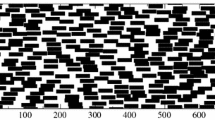A continuum model of the effective elastic moduli of transversely isotropic porous materials with nonspherical pores is proposed. A distinctive feature of the model is calculation of the concentration ratios of average strains of the Hill model by using the effective volumes of averaging of phase strains. Quantitatively, these volumes are the ratios of strains in the volume of a phase to the sum of strains in the volume of entire composite. The effective volumes of averaging for a nonspherical porous material are expressed in terms of the effective volumes of averaging of an isotropic material with spherical pores and Eshelby tensors. The calculated elastic moduli of a transversely isotropic material are in good agreement with experimental data.




Similar content being viewed by others
References
J. Eshelby, Continuum Theory of Dislocations [Russian translation], Izdat. Inostr. Liter. [Russian translation], Moscow (1963).
T. Mori and K. Tanaka, “Average stress in matrix and average elastic energy of materials with misfitting inclusions,” Acta Metallurgica, 21, 571-574 (1973).
Y. H. Zhao, G. P. Tandon, and G. J. Weng, “Elastic moduli for a class of porous materials,” Acta Mechanica, 76, 105-130 (1989).
M. S. Koval’chenko, “Mechanical properties of isotropic porous materials. Elastic and rheological properties,” Poroshk. Metallurg., No. 3, 89-96 (1993).
A. F. Fedotov, “Prediction of the elastic moduli of composites with isolated inclusions by the method of effective volumes of averaging,” Mech. Compos. Mater., 50, No. 6, 777-788 (2014).
J. Sendetski (ed.), Elastic Properties of Composites Mechanics of Composite Materials. Composite materials. 2, Mechanics of Composite Materials [Russian translation], Mir, Moscow (1978).
A. F. Fedotov, “Variant of the continuum model of elastic and plastic properties of powder materials,” Poroshk. Metallurg., Nos. 5/6, 67-82 (2011).
S. Gong, Z. Li, and Y. Y. Zhao, “An extended Mori–Tanaka model for the elastic moduli of porous materials of finite size,” Acta Materialia, 59, 6820-6830 (2011).
H. Nakajima, “Fabrication, properties and application of porous metals with directional pores,” Progr. Materials Sci., 52, 1091-1173 (2007).
T. Mura, Micromechanics of Defects in Solids, Kluwer Academic Publ. (1987).
R. M. Christensen, Mechanics of Composite Materials, John Wiley & Sons, New York (1979).
Ha Jang-Hoon, Kim Jong Ho, and Kim Do Kyung, “Elasticity and thermal conductivity of porous ceramics with controlled pore structure,” J. Ceram. Soc. Japan, Suppl. 112-1, 112, No. 5, 1084-1088 (2004).
Acknowledgments
This study was financially supported by the Russian Fund for Basic Research (Project code No. 16-08-01183a.).
Author information
Authors and Affiliations
Corresponding author
Additional information
Translated from Mekhanika Kompozitnykh Materialov, Vol. 52, No. 3, pp. 451-462, May-June, 2016.
Rights and permissions
About this article
Cite this article
Fedotov, A.F. Variant of the Continuum Model of Effective Elastic Moduli of Transversely Isotropic Porous Materials. Mech Compos Mater 52, 317–324 (2016). https://doi.org/10.1007/s11029-016-9584-1
Received:
Revised:
Published:
Issue Date:
DOI: https://doi.org/10.1007/s11029-016-9584-1




